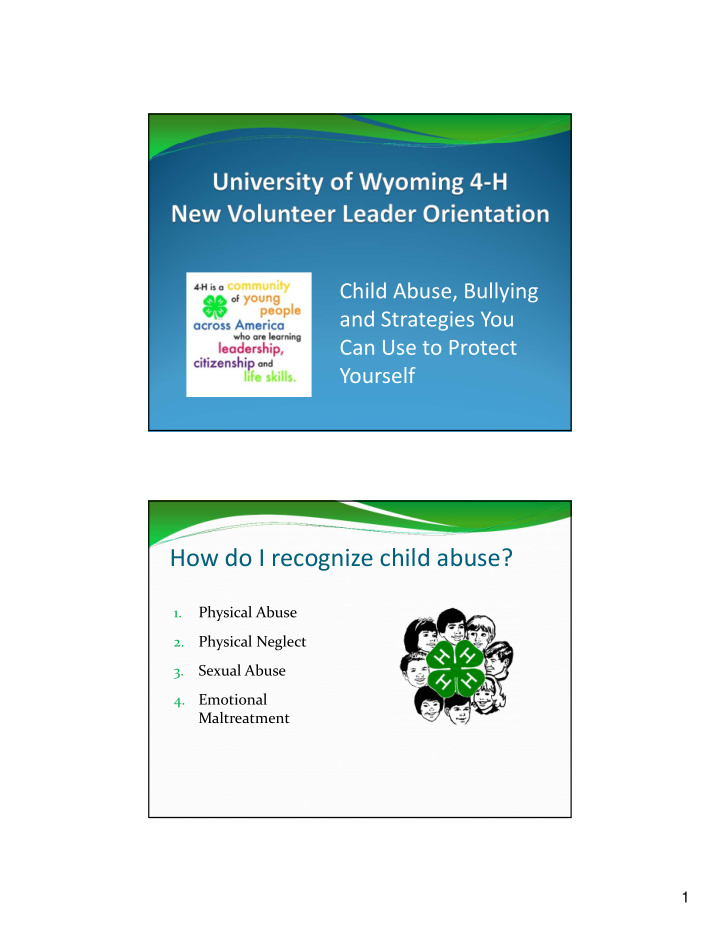



Child Abuse, Bullying and Strategies You Can Use to Protect Yourself How do I recognize child abuse? Physical Abuse 1. Physical Neglect 2. 3. Sexual Abuse 4. Emotional Maltreatment 1
Physical Abuse Physical indicators Behavioral indicators • Unexplained – Self ‐ destructive • bruises Uncomfortable with physical contact • welts Complains of soreness • human bites or moves uncomfortably • bald spots • burns • lacerations Physical Neglect Behavioral indicators Physical indicators Reports no caretaker at Unattended medical needs home Self ‐ destructive Consistent hunger Regularly fatigued, Inappropriate dress listless Poor hygiene 2
Sexual Abuse Physical indicators Behavioral indicators Often no visible Inappropriate sex play indicators or premature understanding of sex Excessive seductiveness and touching Touching may not be appropriate and there is too much Emotional Maltreatment Physical indicators Behavioral indicators Speech disorders Habit disorders (sucking, rocking) Delayed physical development Antisocial, destructive Substance abuse Passive ‐ aggressive 3
How to respond to a child who discloses abuse: Believe the child Talk privately and listen to the child Reassure the child that he/she has done the right thing by talking with you Tell the child you must report to someone who can help him/her Report immediately DO NOT: Promise confidentiality Ask leading or suggestive questions Make negative comments about involved person DO NOT Investigate on your own! 4
Youth Protection You must report to law enforcement or child protective agencies if you have reasonable cause to suspect child abuse or neglect (WY Statute 14 ‐ 3 ‐ 205). Not reporting suspected abuse has consequences. You can anonymously report but remember if there is no record of you reporting it, you can still be prosecuted. Decide if anonymity outweighs risk of reporting openly. It is illegal to intentionally file a false. What is Bullying? Bullying is a widespread and serious problem that can happen anywhere. It is not a phase children have to go through, it is not "just messing around", and it is not something to grow out of. Bullying can cause serious and lasting harm. Most bullying involves: Imbalance of Power Intent to Cause Harm Repetition 5
Types of Bullying Verbal: name ‐ calling, teasing Social : spreading rumors, leaving people out on purpose, breaking up friendships Physical : hitting, punching, shoving Cyberbullying: using the Internet, mobile phones or other digital technologies to harm others An act of bullying may fit into more than one of these groups and can happen to people of any age. For example: youth vs. youth, parent vs. youth, parent vs. leader, leader vs. youth. Some basic suggestions include: Adults should avoid being alone with one child. In group situations it is advisable to always have at least two adults present. Encourage parents to join in your activities or drop in when they can. Have children use the buddy system – they don’t go anywhere without their “buddy”. Don’t leave children alone after a meeting or event. 6
Suggestions, Continued Hugs are okay if they are appropriate and if both people are comfortable with them. Take clues from body language of the child or simply ask, “Is it okay for me to hug you?” Be aware of children’s personal boundaries and respect them. Never hit or strike a child – even in “play”. No wrestling or rough ‐ housing with youth. Use positive reinforcement in an understanding tone – no belittling comments Thanks for completing this orientation. Please remember… complete the evaluation on the State • 4 ‐ H Web Site, and • set up an appointment to meet with your County 4 ‐ H Educator 7
Recommend
More recommend